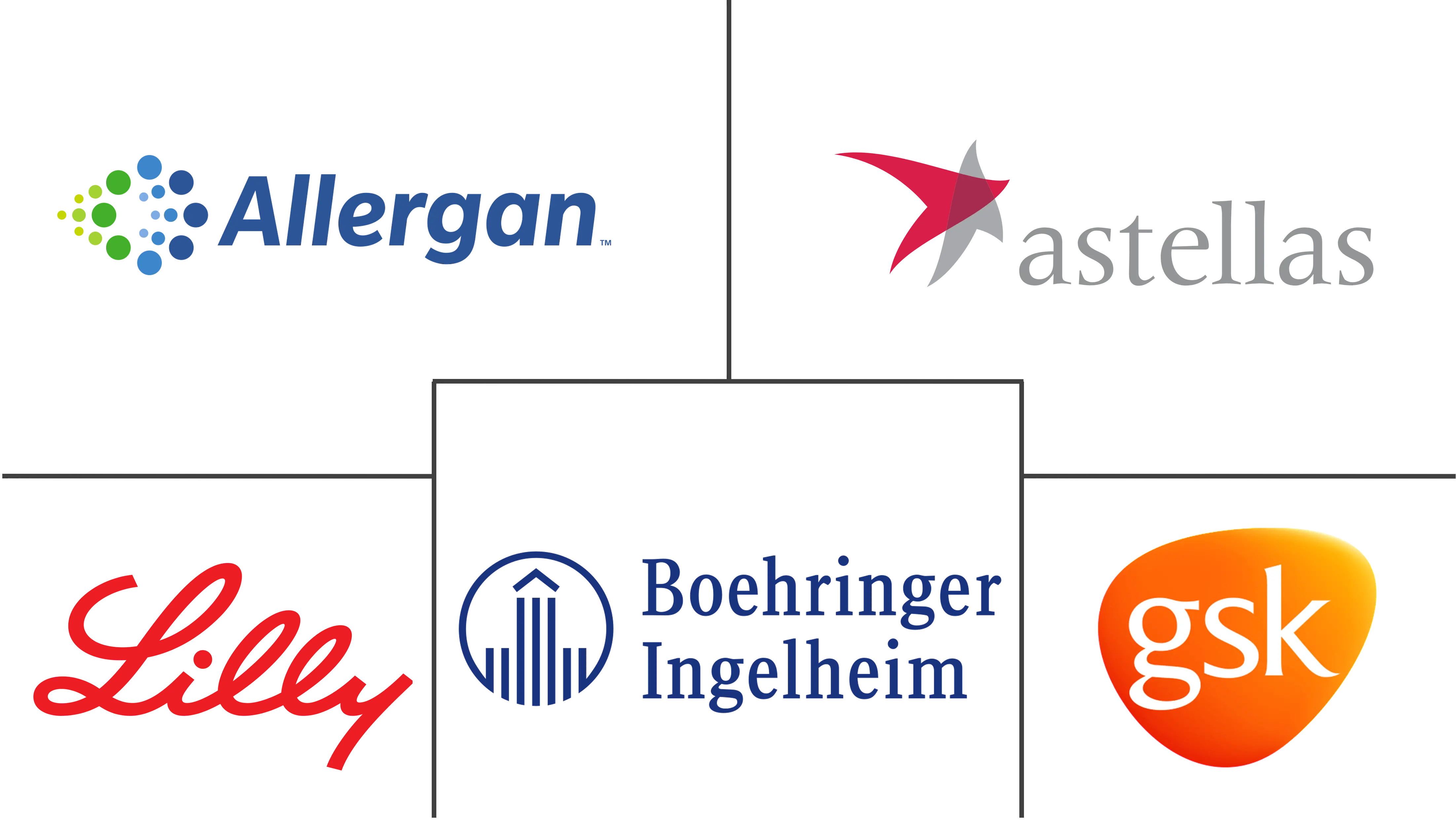Benign Prostatic Hyperplasia Market Size and Share
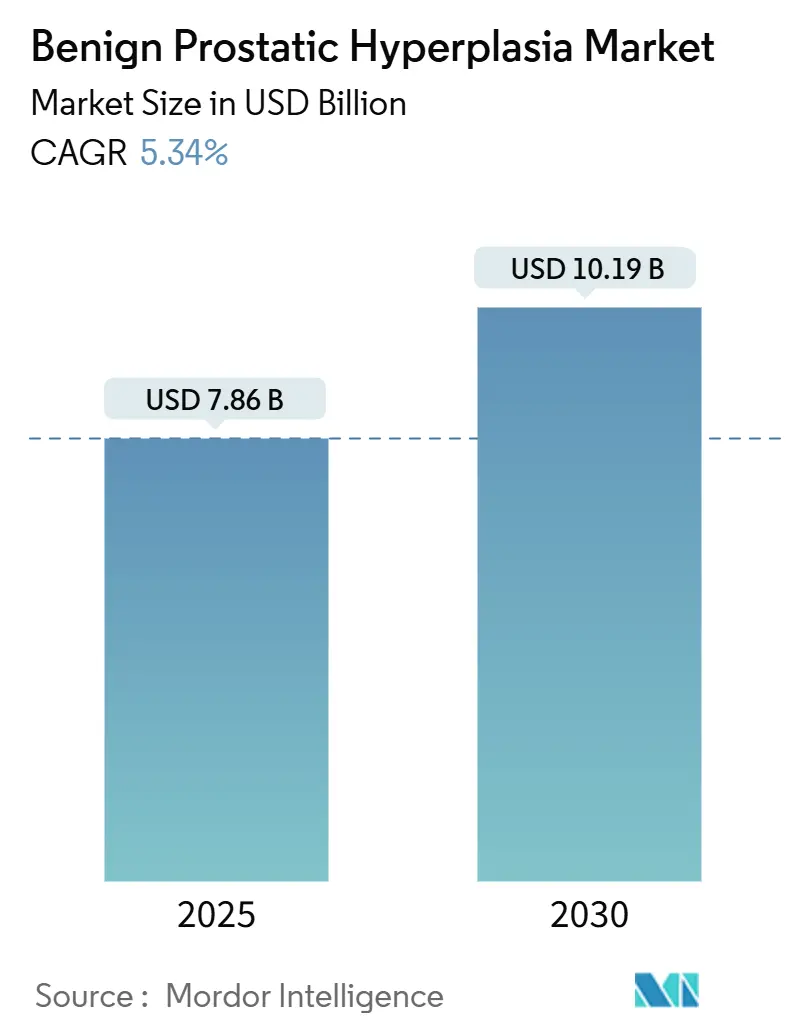
Benign Prostatic Hyperplasia Market Analysis by Mordor Intelligence
The Benign Prostatic Hyperplasia Market size is estimated at USD 7.86 billion in 2025, and is expected to reach USD 10.19 billion by 2030, at a CAGR of 5.34% during the forecast period (2025-2030).
Growth stems from the rising global population of men aged ≥ 50, rapid uptake of tele-urology services, and the steady migration toward fixed-dose combination (FDC) products that promise faster symptom relief with fewer sexual side effects. North America remains the largest regional opportunity, supported by integrated electronic health records that streamline renewal prescriptions, while Asia-Pacific is advancing the fastest as China’s national screening campaigns accelerate early diagnosis. Competition is intensifying as minimally invasive surgical therapies (MISTs) such as Aquablation and UroLift win payer backing, prompting drug makers to emphasize real-world evidence around quality-of-life improvement. In parallel, e-commerce pharmacies are widening patient access and nudging adherence rates upward by enabling discreet home delivery and automated refill reminders.
Key Report Takeaways
- By Drug Class, Alpha-Blockers led with 45.54% market share in 2024; PDE-5 Inhibitors are forecast to expand at a 6.98% CAGR through 2030.
- By Dosage Form, Immediate-Release Tablets/Capsules held 58.15% of the market share in 2024, while Orally Disintegrating Tablets recorded the highest projected CAGR at 5.67% through 2030.
- By Distribution Channel, Retail & Community Pharmacies accounted for 50.67% share of the BPH drugs market in 2024; E-commerce & Mail-Order is advancing at a 6.04% CAGR through 2030.
- By Geography, North America commanded 39.87% of the market share in 2024, while Asia-Pacific recorded the fastest projected CAGR at 7.01% through 2030.
Global Benign Prostatic Hyperplasia Market Trends and Insights
Driver Impact Analysis
| Driver | (~) % Impact on CAGR Forecast | Geographic Relevance | Impact Timeline |
|---|---|---|---|
| Surge of Tele-urology Platforms Expanding Prescription Volumes in North America | +1.20% | North America, with spillover to Europe | Medium term (2-4 years) |
| National Prostate Health Screening Campaigns Elevating Diagnosis Rates in China | +1.50% | China, with influence across Asia-Pacific | Medium term (2-4 years) |
| Government Price Caps on Generic Drugs | +0.70% | Global, with emphasis on emerging markets | Short term (≤ 2 years) |
| Reimbursement Expansion for Dutasteride/Tamsulosin FDC | +1.10% | North America, Europe | Medium term (2-4 years) |
| Rising Preference for Combination α-Blocker/5-ARI Fixed-Dose Pills in Europe | +1.00% | Europe, with expansion to North America | Medium term (2-4 years) |
| Accelerated Private Urology Clinic Build-outs Across GCC Nations | +0.80% | GCC countries, with spillover to Middle East | Short term (≤ 2 years) |
| Source: Mordor Intelligence | |||
Surge of Tele-urology Platforms Expanding Prescription Volumes in North America
Telehealth now manages up to 30% of outpatient urology visits with patient-satisfaction levels above 85% Scientific Reports. Rural areas benefit most; earlier care access has narrowed the historical 20% urban–rural mortality gap tied to prostate conditions[1]Source: David Sheyn, “Rural Health Disparities in Urologic Care,” auanews.net . Integrated data feeds let clinicians track International Prostate Symptom Score (IPSS) trends remotely, facilitating timely shifts to combination therapy once monotherapies plateau. Automated refill alerts on these platforms curtail the 30% discontinuation rate historically linked to adverse sexual effects, thereby elevating lifetime prescription volume.
National Prostate Health Screening Campaigns Elevating Diagnosis Rates in China
Under Healthy China 2030, municipal clinics conduct routine prostate checks, markedly increasing early-stage BPH detection. Acceptance of foreign clinical dossiers has shortened launch timelines for innovative therapies, giving global manufacturers faster on-ramp to the world's largest patient pool. Enhanced reimbursement from the National Medical Security Bureau further supports medicine uptake, extending therapy duration before surgical referral and inflating cumulative drug spending.
Government Price Caps on Generic Drugs
Policy actions such as the U.S. Medicare Prescription Drug Inflation Rebate Program are flattening list-price increases, squeezing margins on tamsulosin and finasteride generics. Branded FDCs are shielded by clinical differentiation, prompting manufacturers to position them within value-based agreements tying payer spend to reduction in acute urinary retention episodes. In emerging markets, volume-based procurement offsets margin pressure for firms with efficient supply chains.
Reimbursement Expansion for Dutasteride/Tamsulosin FDC
Clinical evidence from the CombAT study shows superior symptom relief versus monotherapies, prompting payers to broaden coverage for fixed-dose combinations. Despite isolated formulary removals, such as Blue Cross Blue Shield of Massachusetts delisting Jalyn effective 2025, real-world data show fewer surgical conversions, encouraging value-based contracts that favor FDCs in capitated systems.
Restraint Impact Analysis
| Restraint | (~) % Impact on CAGR Forecast | Geographic Relevance | Impact Timeline |
|---|---|---|---|
| Finasteride Sexual-Side-Effect Concerns Dampening Adherence | -0.90% | Global, with higher impact in developed markets | Long term (≥ 4 years) |
| Rising Preference for Minimally Invasive Procedures Cannibalizing Drug Revenues | -1.30% | North America, Europe, developed Asia | Medium term (2-4 years) |
| Shortage of Fellowship-Trained Endourologists in Sub-Saharan Africa | -0.70% | Sub-Saharan Africa, with spillover to emerging markets | Long term (≥ 4 years) |
| Source: Mordor Intelligence | |||
Finasteride Sexual-Side-Effect Concerns Dampening Adherence
Post-marketing surveillance links finasteride to persistent erectile dysfunction and reduced libido, prompting hazard-ratio-verified follow-up visits well after cessation. Younger cohorts place a premium on sexual function, elevating discontinuation to near 30%. The trend is steering prescribers toward alpha-blockers or FDCs that combine finasteride with tadalafil, a PDE-5 inhibitor shown to mitigate sexual adverse events.
Rising Preference for Minimally Invasive Procedures Cannibalizing Drug Revenues
UroLift, Rezūm, and Aquablation promise durable symptom relief and preserve sexual function. Two randomized trials presented at AUA 2025 showed UroLift delivering superior IPSS reduction within three months compared with tamsulosin, prompting 70% of medication-only patients to cross over to the device arm [2]Source: Teleflex Incorporated, “New Clinical Data Presented at AUA 2025,” urolift.com . Cost-effectiveness models position prostatic artery embolization at USD 64,842 per QALY versus long-term pharmacotherapy, encouraging insurers to pre-authorize MISTs earlier in the care continuum.
Segment Analysis
By Drug Class: Combination Therapies Edge Toward Mainstream
Alpha-blockers generated the largest revenue base in 2024, holding 45.54% of benign prostatic hyperplasia drugs market share. Tamsulosin 0.4 mg remains the anchor therapy given its rapid onset and favorable cardiovascular profile. Yet, PDE-5 inhibitors are pacing the highest 6.98% CAGR, benefiting from dual urological and sexual-health indications that enhance compliance. FDCs such as dutasteride/tamsulosin (Jalyn) and finasteride/tadalafil (ENTADFI) integrate prostate-volume reduction with erectile-function support, expanding their addressable audience among sexually active patients. Network meta-analyses confirm that alpha-blocker + PDE-5 inhibitor regimens significantly outscore monotherapies on IPSS and quality-of-life scales.
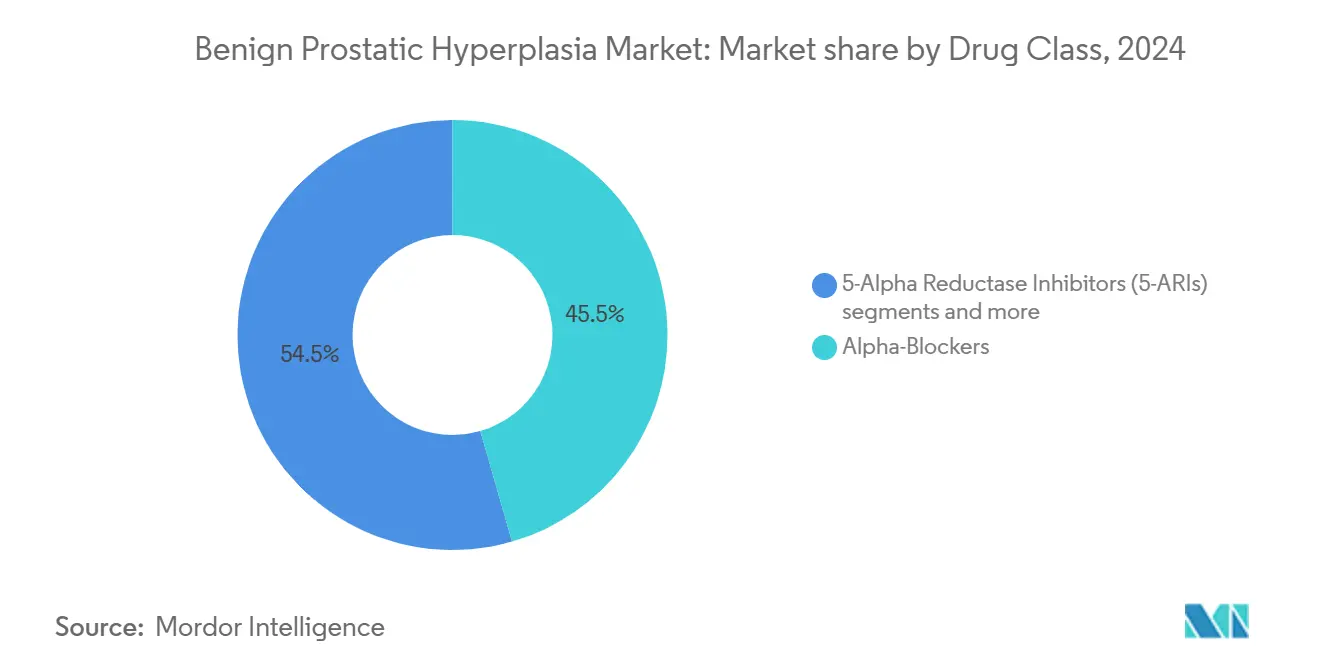
Note: Segment shares of all individual segments available upon report purchase
By Dosage Form: Orally Disintegrating Tablet Adoption Gathers Pace
Immediate-release tablets accounted for 58.15% of benign prostatic hyperplasia drugs market size in 2024, reflecting established production lines and low unit costs. Softgel technology remains central to dutasteride delivery, optimizing solubility of lipophilic actives. Patient-centric innovation is now tilting development toward orally disintegrating tablets (ODTs). Tadalafil ODT (Chewtadzy) debuted in mid-2024, offering swallow-free administration that appeals to older adults with dysphagia. Taste-masking and moisture-barrier advances are enabling life-cycle extension strategies, with multiple ODT filings under review for 2026 launch.
By Distribution Channel: Digital Dispensing Accelerates
Retail pharmacies supplied half of all prescriptions in 2024, aided by counseling services and real-time benefits checks that streamline reimbursement. Hospital pharmacies underpin initiation during acute urinary retention episodes, particularly when inpatient status facilitates baseline labs and blood-pressure monitoring. E-commerce and mail-order outlets are the breakout channel, targeting a 6.04% CAGR as tele-urology scripts are routed directly to partnered fulfillment centers. Early evidence shows that automated refill scheduling via online portals lifts medication-possession ratios above 80%, a threshold seldom achieved in brick-and-mortar settings.
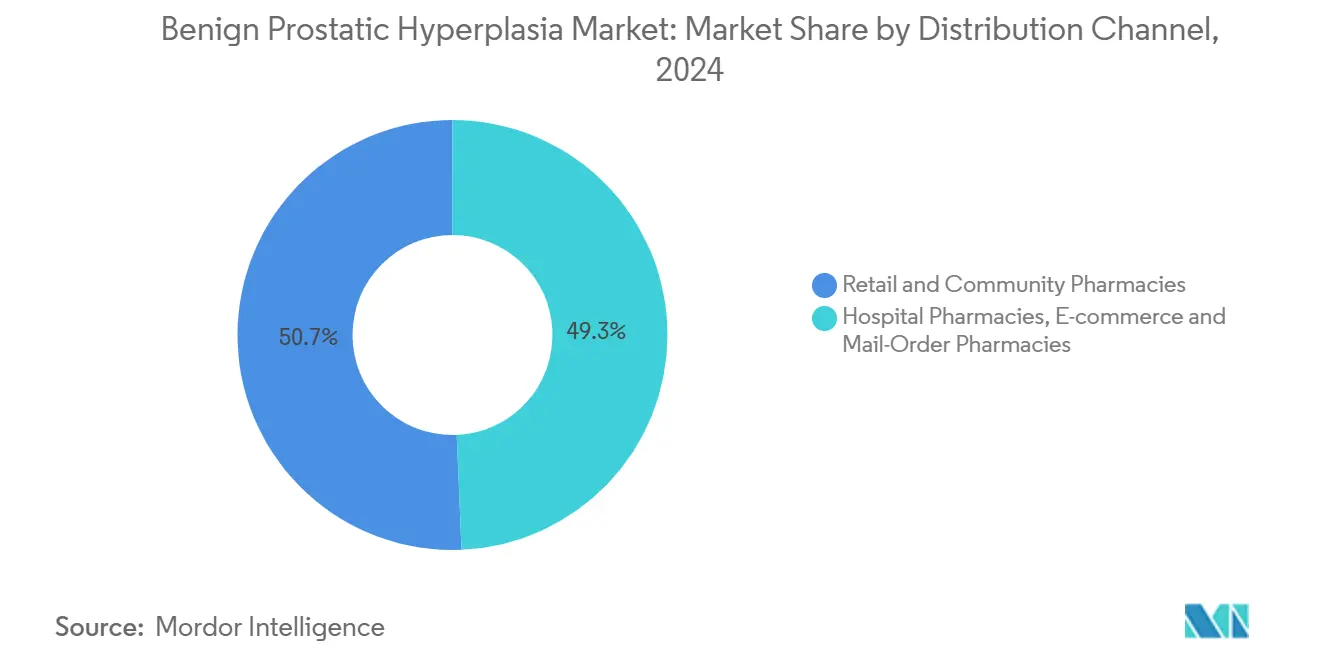
Note: Segment shares of all individual segments available upon report purchase
Geography Analysis
North America commanded 39.87% of 2024 revenue, underpinned by broad insurance coverage and high diagnostic penetration. The U.S. Inflation Rebate Program tempers list-price inflation yet sustains access to combination products viewed as reducing downstream surgical costs. Formularies remain fluid; the 2025 Blue Cross Blue Shield of Massachusetts exclusion of Jalyn and Entadfi underscores the need for sophisticated market-access strategies bluecrossma.org. Canada benefits from pan-provincial prostate-health campaigns, while Mexico’s Seguro Popular expansion propels generic uptake.
Asia-Pacific is the fastest-growing geography at 7.01% CAGR. China’s Healthy China 2030 initiative has normalized annual prostate screening in community clinics, tripling early-stage diagnosis rates and filling the therapy funnel. Japan's prescription volume for alpha-1 blockers increased, reflecting greater physician comfort with pharmacologic management. India and South Korea show momentum as public-sector hospitals integrate tele-urology pilots that shorten specialist waitlists.
Europe maintains a solid installed base, but rigorous health-technology assessments compress price–volume corridors. Germany and France favor FDCs with documented reduction in acute urinary retention, while the UK’s National Institute for Health and Care Excellence (NICE) is reassessing cost utility of MISTs versus lifelong medication. In the Middle East & Africa, Gulf Cooperation Council states are investing in urology centers that import branded alpha-blockers, whereas most sub-Saharan systems rely on low-cost generics, leaving pockets of unmet need. South America, led by Brazil, is widening insurance formularies for dutasteride after domestic real-world studies linked therapy persistence to lower hospitalization.
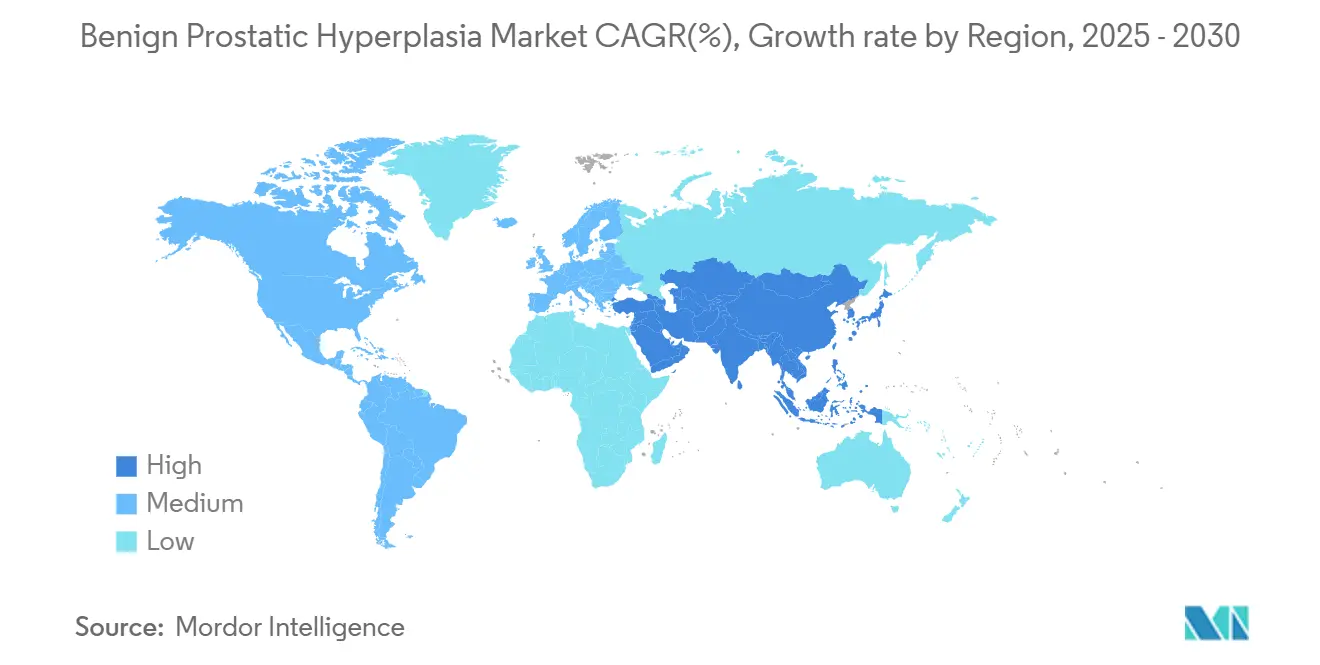
Competitive Landscape
The competitive field is moderately concentrated. GlaxoSmithKline, Viatris, and Astellas anchor incumbency with deep distribution and portfolios spanning monotherapies and FDCs. Innovation focus has shifted to patient-centric formulations and digital-health companions that boost adherence. 2025 data showed Teleflex's UroLift System delivered superior early IPSS and sexual-function outcomes compared with Rezūm and tamsulosin. PROCEPT BioRobotics logged a 57% revenue jump in Q4 2024 on Aquablation console uptake, signaling accelerating competition from surgical modalities.
Pharma responses include lifecycle-management tactics: GSK is exploring once-weekly dutasteride implants, while Astellas pilots app-based IPSS trackers that feed dosing-adjustment algorithms. Reimbursement turbulence drives diversification; Buckeye Health Plan's 2025 shift of silodosin from Part D to Part B demands new billing workflows yet positions office-dispensed therapy favorably for urologists. Emerging players such as Medicus Pharma aim to introduce Teverelix, a GnRH antagonist targeting acute urinary retention prevention, broadening mechanism diversity in the benign prostatic hyperplasia drugs market.
Benign Prostatic Hyperplasia Industry Leaders
-
Allergan PLC
-
Eli Lilly and Company
-
Merck & Co., Inc.
-
Boehringer Ingelheim
-
Astellas Pharma Inc.
- *Disclaimer: Major Players sorted in no particular order
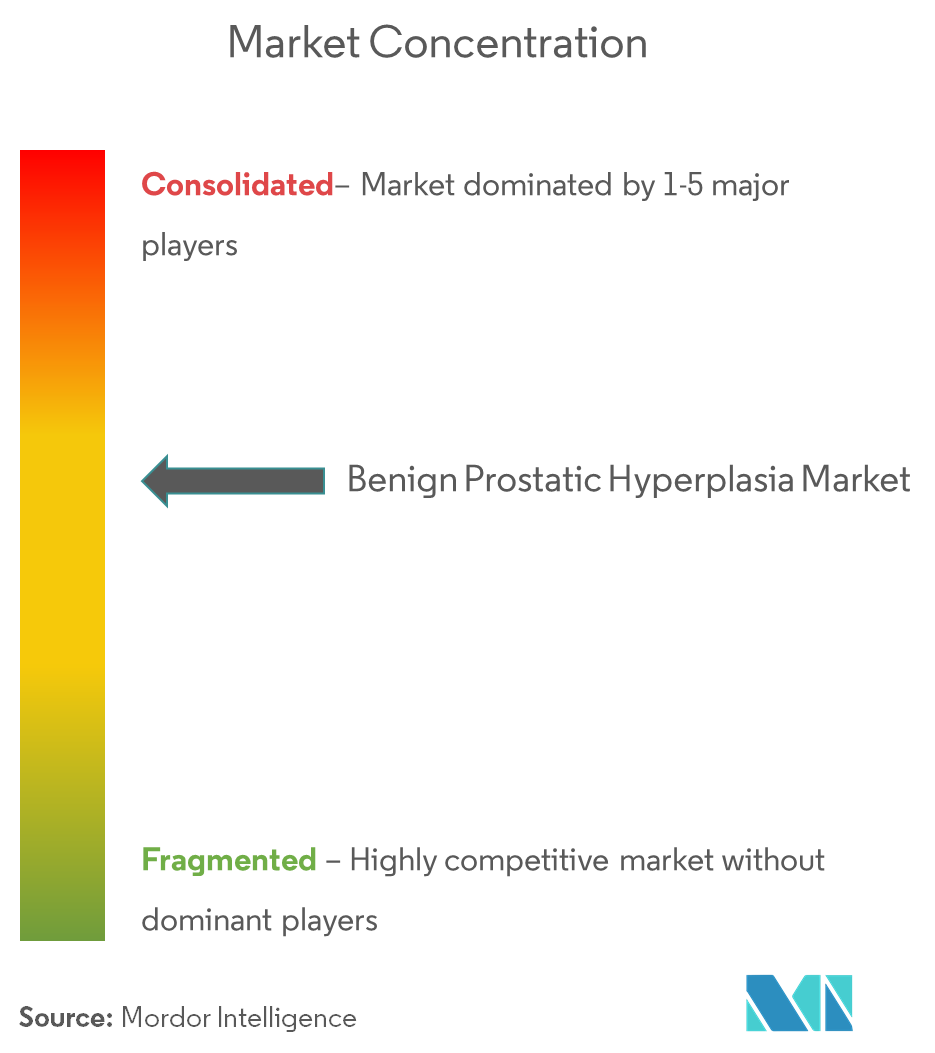


Recent Industry Developments
- April 2025: Medicus Pharma signed a USD 75 million deal to acquire Antev and secure Teverelix, targeting prevention of acute urinary retention linked to BPH.
- January 2025: Blue Cross Blue Shield of Massachusetts removed Avodart, Entadfi, Jalyn, and Proscar from its 2025 formulary, altering brand access dynamics
Research Methodology Framework and Report Scope
Market Definitions and Key Coverage
Benign prostatic hyperplasia drugs are defined by Mordor Intelligence as all prescription oral or soft-gel pharmaceutical products whose primary indication is the reduction of prostatic tissue mass or relief of lower urinary tract symptoms arising from non-malignant prostate enlargement in men aged ≥ 40 years. The study quantifies revenues generated from alpha-blockers, 5-alpha-reductase inhibitors, phosphodiesterase-5 inhibitors, and fixed-dose combinations sold through hospital, retail, and e-pharmacy channels across 17 major countries.
Scope exclusion: The model deliberately omits minimally invasive surgical therapies, energy-based devices, supplements, and catheter sales, ensuring that only systemic drug revenue is tracked.
Segmentation Overview
- By Drug Class
- Alpha-Blockers
- 5-Alpha Reductase Inhibitors (5-ARIs)
- Phosphodiesterase-5 (PDE-5) Inhibitors
- Combination Therapies (α-Blocker + 5-ARI / PDE-5)
- Others
- By Dosage Form
- Oral Immediate-Release Tablets / Capsules
- Oral Extended-Release Tablets
- Softgel Capsules
- Orally Disintegrating Tablets (ODT)
- By Distribution Channel
- Hospital Pharmacies
- Retail & Community Pharmacies
- E-commerce & Mail-Order Pharmacies
- By Geography
- North America
- United States
- Canada
- Mexico
- Europe
- Germany
- United Kingdom
- France
- Italy
- Spain
- Rest of Europe
- Asia-Pacific
- China
- Japan
- India
- South Korea
- Australia
- Rest of Asia-Pacific
- Middle East and Africa
- GCC
- South Africa
- Rest of Middle East and Africa
- South America
- Brazil
- Argentina
- Rest of South America
- North America
Detailed Research Methodology and Data Validation
Primary Research
Structured interviews with urology clinicians, hospital pharmacy buyers, and regional KOLs in North America, Europe, and Asia helped verify average daily doses, switching patterns, and emerging fixed-dose adoption. Follow-up surveys with distributors provided cross-checks on channel mark-ups and refill rates.
Desk Research
Mordor analysts first assembled incidence, prevalence, and treated-patient data from tier-1, open sources such as the World Health Organization, U.S. National Institutes of Health, Eurostat, and Japan's Ministry of Health. Regulatory agency drug utilization dashboards, national formularies, and customs export records clarified molecule availability and typical pack pricing. Additional context came from peer-reviewed journals, urology association white papers, and listed company 10-K filings. Paid intelligence from D&B Hoovers and Dow Jones Factiva supplemented competitive financials and recent launch news. The sources named are illustrative; many others were consulted during validation.
Market-Sizing & Forecasting
A top-down epidemiology build mapped diagnosed BPH prevalence to treated cohorts, applying therapy penetration and adherence ratios to derive annual standard-unit demand, which was then multiplied by blended ex-factory average selling prices. Bottom-up rollups of selected manufacturer revenues and channel checks anchored the totals and corrected country-level skews. Key variables like male population ≥ 50 years, urologist density, generic share trajectory, and reimbursement changes drive the model, while prescription volume elasticities are forecast through multivariate regression augmented by scenario analysis for patent expiries.
Data Validation & Update Cycle
Outputs undergo variance checks against trade data, consensus forecasts, and prior editions before a senior analyst sign-off. The dataset is refreshed every twelve months, with interim adjustments when regulatory approvals or guideline changes create material shifts.
Why Mordor's Benign Prostatic Hyperplasia Baseline Commands Reliability
Published figures often diverge because publishers mix drugs with procedures, apply dissimilar prevalence assumptions, or freeze exchange rates too early. By isolating prescription pharmacotherapy only and revisiting both epidemiology and price curves annually, Mordor delivers a balanced starting point for planners.
Key gap drivers include broader treatment scope in some studies, omission of fixed-dose combinations in others, and inconsistent currency conversions.
Benchmark comparison
| Market Size | Anonymized source | Primary gap driver |
|---|---|---|
| USD 7.86 B (2025) | Mordor Intelligence | - |
| USD 12.62 B (2024) | Global Consultancy A | Adds surgical revenues and device ancillaries |
| USD 12.49 B (2024) | Trade Journal B | Lumps surgeries with drugs, uses list prices |
| USD 6.36 B (2024) | Industry Association C | Excludes PDE-5 combos and applies limited geography |
These contrasts show that Mordor's disciplined scope, multi-source validation, and yearly refresh provide decision-makers with a dependable, easily traceable benchmark.


Key Questions Answered in the Report
What is the current Benign Prostatic Hyperplasia Market size?
The Benign Prostatic Hyperplasia Market is projected to register a CAGR of 8.5% during the forecast period (2025-2030)
What is the current benign prostatic hyperplasia drugs market size?
The benign prostatic hyperplasia drugs market size is USD 7.86 billion in 2025 and is projected to reach USD 10.19 billion by 2030.
Which region is growing fastest in BPH drug sales?
Asia-Pacific leads growth with a 7.01% CAGR forecast for 2025-2030, driven primarily by China’s nationwide prostate-health initiatives.
Which drug class dominates prescription volume?
Alpha-blockers remain the largest class, accounting for 45.54% of benign prostatic hyperplasia drugs market share in 2024.
Why are minimally invasive procedures affecting drug demand?
Procedures such as UroLift and Aquablation deliver rapid symptom relief while preserving sexual function, encouraging some patients to switch away from lifelong medication.
How is telemedicine influencing BPH drug adherence?
Tele-urology platforms integrate refill reminders and remote IPSS tracking, cutting discontinuation rates and expanding prescription volumes, especially in rural areas.
Page last updated on:
